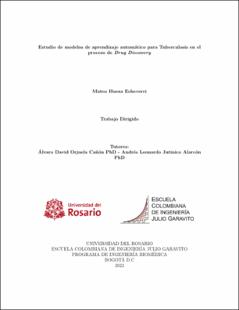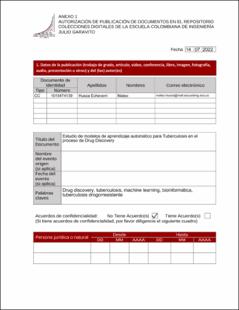Mostrar el registro sencillo del ítem
Estudio de modelos de aprendizaje automático para Tuberculosis en el proceso de Drug Discovery
| dc.contributor.advisor | Orjuela Cañón, Ávaro David | |
| dc.contributor.advisor | Jutínico Alarcón, Andrés Leonardo | |
| dc.contributor.author | Hueza Echeverri, Mateo | |
| dc.date.accessioned | 2022-07-28T20:17:50Z | |
| dc.date.available | 2022-07-28T20:17:50Z | |
| dc.date.issued | 2022 | |
| dc.identifier.uri | https://repositorio.escuelaing.edu.co/handle/001/2095 | |
| dc.description.abstract | En este documento se presenta un proyecto de investigación planteado desde el área de la bioinformática, en el que se busca dar una solución a la actual problemática de la drogorresistencia en tres proteínas presentes en cepas resistentes la especie bacteriana Mycobaterium tuberculosis. Se busca plantear y comparar modelos de predicción de valores de pIC50 (escala logarítmica del IC50), que hace referencia a la concentración necesaria del fármaco para disminuir la actividad de la proteína en un 50 %. Esta predicción servirá para nuevos fármacos, tomando como punto de partida la estructura molecular de compuestos químicos ya conocidos. Para ello se caracterizan con los datos provenientes de la base ChEMBL[3] y que tengan como proteína objetivo las proteínas N-Acetiltransferasa codificada por el gen eis, la ATP sintentasa subunidad c codificada por el gen atpE y por la Subunidad beta de ARN polimerasa dirigida por ADN codificada por el gen rpoB. Se esocogen estas proteínas dado que en ellas se presenta la resistencia a ciertos fármacos bactericidas de segunda y tercera línea. A cada compuesto se le calculan descriptores relacionados con la ley de lipinski: el peso molecular (MW), número de donadores de enlaces por puentes de hidrógeno (NumHDonnors), número de aceptores de enlaces por puentes de hidrógeno (NumHAcceptors) y el coeficinente de reparto octanol/agua (LogP); de igual manera se calcula una huella que cuenta con 881 descriptores que junto con los cuatro ya mencionados, se toman como la entrada de los modelos de regresión a plantear y los valores de pIC50 conocidos se toman como salida. Lo anterior corresponde al conjunto de entrenamiento con el que se generan diferentes modelos de regresión para esta predicción del pIC50. Para finalizar se comparan las características de funcionamiento de los modelos para así establecer los más adecuados para la problemática. | spa |
| dc.description.abstract | This document presents a research project proposed from the area of bioinformatics, which seeks to provide a solution to the current problem of drug resistance in three proteins present in resistant strains of the bacterial species Mycobacterium tuberculosis. The aim is to propose and compare prediction models for pIC50 values (logarithmic scale of IC50), which refers to the concentration of the drug necessary to reduce protein activity by 50%. This prediction will serve for new drugs, taking as a starting point the molecular structure of already known chemical compounds. To do this, they are characterized with the data from the ChEMBL[3] database and that have as their target protein the N-Acetyltransferase proteins encoded by the eis gene, the ATP synthetase subunit c encoded by the atpE gene and by the RNA polymerase beta subunit directed by DNA encoded by the rpoB gene. These proteins are chosen because they show resistance to certain second- and third-line bactericidal drugs. Descriptors related to Lipinski's law are calculated for each compound: molecular weight (MW), number of hydrogen bond donors (NumHDonnors), number of hydrogen bond acceptors (NumHAcceptors) and the coefficient of octanol/water partition (LogP); In the same way, a fingerprint is calculated that has 881 descriptors that, together with the four already mentioned, are taken as the input of the regression models to be proposed and the known pIC50 values are taken as output. The above corresponds to the training set with which different regression models are generated for this pIC50 prediction. Finally, the operating characteristics of the models are compared in order to establish the most appropriate for the problem. | eng |
| dc.format.extent | 27 páginas | spa |
| dc.format.mimetype | application/pdf | spa |
| dc.language.iso | spa | spa |
| dc.title | Estudio de modelos de aprendizaje automático para Tuberculosis en el proceso de Drug Discovery | spa |
| dc.type | Trabajo de grado - Pregrado | spa |
| dc.type.version | info:eu-repo/semantics/publishedVersion | spa |
| oaire.accessrights | http://purl.org/coar/access_right/c_abf2 | spa |
| oaire.version | http://purl.org/coar/version/c_970fb48d4fbd8a85 | spa |
| dc.description.degreelevel | Pregrado | spa |
| dc.description.degreename | Ingeniero(a) Biomédico(a) | spa |
| dc.identifier.url | https://catalogo.escuelaing.edu.co/cgi-bin/koha/opac-detail.pl?biblionumber=23085 | |
| dc.identifier.url | https://catalogo.escuelaing.edu.co/cgi-bin/koha/opac-detail.pl?biblionumber=23083 | spa |
| dc.publisher.program | Ingeniería Biomédica | spa |
| dc.relation.indexed | N/A | spa |
| dc.relation.references | A. Natarajan, P. Beena, A. V. Devnikar y S. Mali, «A systemic review on tuberculosis,» Indian Journal of Tuberculosis, vol. 67, n.o 3, págs. 295-311, 2020 | spa |
| dc.relation.references | A. Zabaleta y C. Llerena, «Extensively resistant tuberculosis, Colombia, 2006-2016,» Biomedica, vol. 39, n.o 4, págs. 707-714, 2019, | spa |
| dc.relation.references | D. Mendez, A. Gaulton, A. P. Bento et al., «ChEMBL: towards direct deposition of bioassay data,» Nucleic Acids Research, vol. 47, n.o D1, págs. D930-D940, nov. de 2018. | spa |
| dc.relation.references | C. Silva, V. Bermúdez, N. Arraiz, F. Bermúdez, M. Rodríguez y L. V. E. Leal., «Fármacos de primera línea utilizados en el tratamiento de la tuberculosis,» Archivos Venezolanos de Farmacología y Terapéutica, 2007. | spa |
| dc.relation.references | N. A. Shaik, K. R. Hakeem, B. Banaganapalli y R. Elango, Essentials of Bioinformatics Volume II, In Silico Life Sciences: Medicine. Springer, 2019. | spa |
| dc.relation.references | G. Singh, P. Kesharwani y A. K. Srivastava, «Tuberculosis treated by multiple drugs: An overview,» Current Drug Delivery, vol. 15, n.o 3, págs. 312-320, 2018 | spa |
| dc.relation.references | C. E. Rincón-Torres, V. Rubio, C. Castro et al., «National Network for Knowledge Management, Research, and Innovation in Tuberculosis in Colombia,» Revista Panamericana de Salud Publica/Pan American Journal of Public Health, vol. 45, 2021 | spa |
| dc.relation.references | J. G. Rodríguez-Castillo, C. Llerena, L. Argoty-Chamorro et al., «Population structure of multidrug-resistant Mycobacterium tuberculosis clinical isolates in Colombia,» Tuberculosis, vol. 125, 2020 | spa |
| dc.relation.references | A. Zabaleta, C. Llerena y A. Valbuena, «Tuberculosis resistente en menores de 15 años, Colombia 2010-2015,» Biomedica, vol. 39, n.o 2, págs. 330-338, 2019 | spa |
| dc.relation.references | S. Macalino, J. B. Billones, V. G. Organo y Carrillo, «In Silico Strategies in Tuberculosis Drug Discovery.,» Basel, Switzerland, vol. 25, n.o 3, 2020 | spa |
| dc.relation.references | S. Swaminathan, J. C. Sundaramurthi, A. N. Palaniappan y S. Narayanan, «Recent developments in genomics, bioinformatics and drug discovery to combat emerging drugresistant tuberculosis,» Tuberculosis, vol. 101, págs. 31-40, 2016 | spa |
| dc.relation.references | G. Mugumbate, B. Nyathi, A. Zindoga y G. Munyuki, «Application of Computational Methods in Understanding Mutations in Mycobacterium tuberculosis Drug Resistance,» Frontiers in Molecular Biosciences, vol. 8, 2021 | spa |
| dc.relation.references | X. Chen, J. Sa, M. Li e Y. Zhou, «Combined prediction model of tuberculosis based on generalized regression neural network,» en Proceedings of 2020 IEEE International Conference on Artificial Intelligence and Computer Applications, ICAICA 2020, Cited By :2, 2020, págs. 577-581. | spa |
| dc.relation.references | K. Ghazvini, M. Yousefi, F. Firoozeh y S. Mansouri, «Predictors of tuberculosis: Application of a logistic regression model,» Gene Reports, vol. 17, 2019 | spa |
| dc.relation.references | R. S. Wallis, C. Wang, D. Meyer y N. Thomas, «Month 2 Culture Status and Treatment Duration as Predictors of Tuberculosis Relapse Risk in a Meta-Regression Model,» PLoS ONE, vol. 8, n.o 8, 2013 | spa |
| dc.relation.references | M. Hassam, J. A. Shamsi, A. Khan, A. Al-Harrasi y R. Uddin, «Prediction of inhibitory activities of small molecules against Pantothenate synthetase from Mycobacterium tuberculosis using Machine Learning models,» Computers in biology and medicine, vol. 145, 2022 | spa |
| dc.relation.references | T. R. Lane, F. Urbina, L. Rank et al., «Machine Learning Models for Mycobacterium tuberculosis in Vitro Activity: Prediction and Target Visualization,» Molecular Pharmaceutics, vol. 19, n.o 2, págs. 674-689, 2022 | spa |
| dc.relation.references | Y. Hu, Z. Morichaud, S. Chen, J.-P. Leonetti y K. Brodolin, «Mycobacterium tuberculosis RBPA protein is a new type of transcriptional activator that stabilizes the A -containing RNA polymerase holoenzyme,» Nucleic Acids Research, vol. 40, n.o 14, págs. 6547-6557, 2012 | spa |
| dc.relation.references | M. A. Isa, M. B. Abubakar, M. M. Mohammed, M. M. Ibrahim y F. A. Gubio, «Identification of potent inhibitors of ATP synthase subunit C (AtpE) from mycobacterium tuberculosis using in silico approach,» Heliyon, vol. 7, n.o 12, 2021 | spa |
| dc.relation.references | J. L. Houghton, T. Biswas, W. Chen, O. V. Tsodikov y S. Garneau-Tsodikova, «Chemical and structural insights into the regioversatility of the aminoglycoside acetyltransferase Eis,» European journal of chemical biology, vol. 7, n.o 14, 2013 | spa |
| dc.relation.references | C. W. Yap, «Padel-Descriptor: An Open Source Software to Calculate Molecular Descriptors and Fingerprints,» Journal of Computational Chemistry, vol. 32, n.o 7, 2010 | spa |
| dc.relation.references | C. A. Lipinski, F. Lombardo, B. W. Dominy y P. J. Feeney, «Experimental and computational approaches to estimate solubility and permeability in drug discovery and development settings,» Advanced Drug Delivery Reviews, vol. 46, n.o 1, págs. 3-26, 2001 | spa |
| dc.relation.references | P. R. Duchowicz, C. Talevi A.and Bellera, E. A. Castrp y L. E. Buno-Lanch, «Estudio QSPR Sobre Solubilidades Acuosas de Sustancias Orgánicas,» XXVI Congreso Argentino de Química Dr. Ángel del Carmen Devia, 2006. | spa |
| dc.relation.references | C. Rauch, «Toward a mechanical control of drug delivery. On the relationship between Lipinski’s 2nd rule and cytosolic pH changes in doxorubicin resistance levels in cancer cells: A comparison to published data,» European Biophysics Journal, vol. 38, n.o 7, págs. 829-846, 2009 | spa |
| dc.relation.references | D. S. Diningrat, A. N. Sari, N. S. Harahap y Kusdianti, «IN SILICO STUDY OF THE TOXICITY AND ANTIVIRAL ACTIVITY PREDICTION OF JAMBLANG (Syzygium cumini) LEAVES ESSENTIAL OIL AS ACE2 INHIBITOR,» Pharmacologyonline, vol. 3, págs. 1334-1351, 2021 | spa |
| dc.relation.references | S. Hosseini, S. Ketabi y G. Hasheminasab, «QSAR study of antituberculosis activity of oxadiazole derivatives using DFT calculations,» Journal of Receptors and Signal Transduction, 2022. | spa |
| dc.relation.references | S. Singh, K. R. Ramkumar y A. Kukkar, «Machine Learning Techniques and Implementation of Different ML Algorithms,» en 2021 2nd Global Conference for Advancement in Technology, GCAT 2021, 2021. | spa |
| dc.relation.references | S. Singh, K. R. Ramkumar y A. Kukkar, Python Machine Learning: Unlock deeper insights into Machine Leaning with this vital guide to cutting-edge predictive analytics. 2015 | spa |
| dc.relation.references | F. Pedregosa, G. Varoquaux, A. Gramfort et al., «Scikit-learn: Machine Learning in Python,» Journal of Machine Learning Research, vol. 12, págs. 2825-2830, 2011 | spa |
| dc.relation.references | J. Shao, «Linear model selection by cross-validation,» Journal of the American Statistical Association, vol. 88, n.o 422, págs. 486-494, 1993 | spa |
| dc.rights.accessrights | info:eu-repo/semantics/openAccess | spa |
| dc.subject.armarc | Aprendizaje automático - Tuberculosis | |
| dc.subject.armarc | Bioinformatica | |
| dc.subject.armarc | Ingeniería biomédica | |
| dc.subject.proposal | bioinformática | spa |
| dc.subject.proposal | Aprendizaje automático - Tuberculosis | spa |
| dc.subject.proposal | Ingeniería biomédica | spa |
| dc.subject.proposal | Biomedical engineering | eng |
| dc.type.coar | http://purl.org/coar/resource_type/c_7a1f | spa |
| dc.type.content | Text | spa |
| dc.type.driver | info:eu-repo/semantics/bachelorThesis | spa |
| dc.type.redcol | https://purl.org/redcol/resource_type/TP | spa |
Ficheros en el ítem
Este ítem aparece en la(s) siguiente(s) colección(ones)
-
BA - Trabajos Dirigidos de Biomédica [226]
Trabajos del Pregrado de Ingeniería Biomédica de la Escuela Colombiana de Ingeniería Julio Garavito











